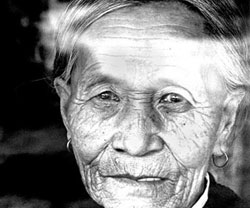The original title for this article is: A Modest Proposal: For the Final Solution of the Comfort Women/Sex Slave Issue
A specter haunts East Asia - the specter of a steadily growing divide between the mounting condemnation of Japan's wartime "sex slave" brutality on one hand, [1] and an increasingly revisionist Japan to deflect, deny or defend its "comfort women" policy on the other. [2] With the polarization of the issue, a radically different approach - which is not only more historical and analytical but also practical - should be considered to accommodate the values and interests of all sides, including those of Japan.
|
 |
| The tradegy of comfort women |
An emerging consensus outside Japan is to redefine the term "comfort women" as "sex slaves". For the 300,000 young Asian women who were duped, abducted, or coerced into Japan's vast network of managed prostitution, [3] the difference between the two phrases means very little because their life was forever altered and mostly ruined. The dichotomy, however, misses two vital pieces in a unique historical triangle of human interaction: millions of the Emperor's soldiers in Asia and hundreds of millions of "untouched" Asian women. Thanks to the timely and systemic "service", or sacrifice, by a fraction of women at the time, these two large human groups were mostly separated, at least in theory.
On January 13 1938, the headquarters of the Japanese Shanghai Expeditionary Forces (SEF) opened a large comfort station named Yangjiazai Entertainment Station in Shanghai, which employed, for the first time, a large number of young Korean women. By the time of Japan's surrender in August 1945, Shanghai had 149 registered comfort stations for the Japanese military, while several thousand comfort stations were in operation across China and beyond, serving millions of Japanese soldiers. [4]
The rapid expansion of the comfort stations from early 1938 onward was an emergency measurement to curtail the widespread rape and murder of Chinese women. In the first few months of Japan's all - out invasion of China during August - December 1937, the fast advance of the SEF from Shanghai to Nanking was not accompanied by adequate comforting, or military prostitution, services. This was one of the root causes for the brutal killing and raping of civilians. For three months following the fall of the Chinese capital city of Nanking in early December 1937, the Emperor's soldiers killed 300,000 Chinese and raped an estimated 20,000 women. Many of those women were killed immediately after being raped, often through explicit mutilation. [5]
The Rape of Nanking, which lasted for more than six weeks until the end of January of 1938, was actually the final phase of a much larger scale of Japanese atrocities after the Battle of Shanghai (August 13 to November 26, 1937). According to a declassified telegraph sent by the US. ambassador to Germany in Berlin one day after the Japanese army occupied Nanking, the US ambassador heard the Japanese Ambassador in Germany boasting that Japanese army killed 500,000 Chinese as the SEF advanced from Shanghai to Nanking. [6]
If this was true, this most beautiful part of the Yangtze River valley - Suzhou, Jiaxing, Hangzhou, Shaoxing, Wuxi and Changzhou - was disproportionally devastated by the Japanese troops racing towards Nanking. There was no record for the number of women raped. If Nanking's 15:1 ratio (300,000 killed and 20,000 raped) is applied here, about 33,333 Chinese women were raped between Shanghai and Nanking in a matter of just two weeks between the end of the SEF's Shanghai operation on November 26 and its siege of Nanking on December 10, 1937. Such a killing and raping spree is yet to be rivaled by any other military in war history.
It was against this backdrop of random and indiscriminate rape and murder of Chinese civilians that the Japanese military raced to expand its comfort services in China. One wonders how millions of Japanese military personnel across Asia would have behaved without proper "comfort" in the next eight years of war.
The real number of comfort women and the ratio with Japanese troops can never be established, [7] given the systematic destruction of documents by the Japanese government and military authorities on the eve of Japan's surrender. [8] Let's take the low estimate of 200,000 comfort women.[9] A semi - official Japanese source estimated that on average a soldier went to a comfort station once a month. [10] Statistically, this means 12 Asian women would not be raped per year and about 90 rapes would not be committed by a particular Japanese soldier over the duration of his overseas deployment until August 1945.
This, in turn, means a total of 315 million rapes would be "avoided" thanks to the visits to comfort stations by the 3.5 million military personnel outside Japan's homeland throughout the war. [11] It is anybody's opinion to consider this an "accomplishment" or an atrocity. Life for hundreds of millions of Asian women outside the "comfort zone" could have been much worse without this human (comfort women) "shield".
The math exercise, however, should be treated with caution. There is no evidence that Japanese military personnel would not rape local women after visiting comfort stations, particularly in punitive operations against civilians who were believed to collaborate with either the communist-led guerrillas or allied forces (Doolittle Raid pilots). For example, Japan's "Three All" operations (kill all, loot all and destroy all) of 1940-42 killed 2.7 million civilians in northern China. In the five months between May and September of 1942, 250,000 Chinese were slaughtered in the areas where the Doolittle pilots landed. [12]